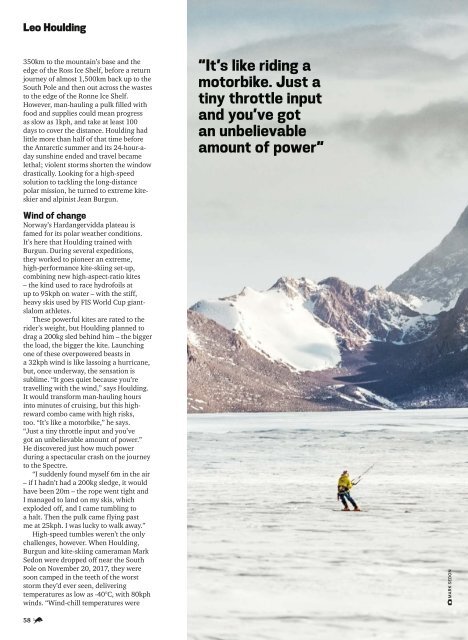Create successful ePaper yourself
Turn your PDF publications into a flip-book with our unique Google optimized e-Paper software.
Leo Houlding<br />
350km to the mountain’s base and the<br />
edge of the Ross Ice Shelf, before a return<br />
journey of almost 1,500km back up to the<br />
South Pole and then out across the wastes<br />
to the edge of the Ronne Ice Shelf.<br />
However, man-hauling a pulk filled with<br />
food and supplies could mean progress<br />
as slow as 1kph, and take at least 100<br />
days to cover the distance. Houlding had<br />
little more than half of that time before<br />
the Antarctic summer and its 24-hour-aday<br />
sunshine ended and travel became<br />
lethal; violent storms shorten the window<br />
drastically. Looking for a high-speed<br />
solution to tackling the long-distance<br />
polar mission, he turned to extreme kiteskier<br />
and alpinist Jean Burgun.<br />
“It’s like riding a<br />
motorbike. Just a<br />
tiny throttle input<br />
and you’ve got<br />
an unbelievable<br />
amount of power”<br />
Wind of change<br />
Norway’s Hardangervidda plateau is<br />
famed for its polar weather conditions.<br />
It’s here that Houlding trained with<br />
Burgun. During several expeditions,<br />
they worked to pioneer an extreme,<br />
high-performance kite-skiing set-up,<br />
combining new high-aspect-ratio kites<br />
– the kind used to race hydrofoils at<br />
up to 95kph on water – with the stiff,<br />
heavy skis used by FIS World Cup giantslalom<br />
athletes.<br />
<strong>The</strong>se powerful kites are rated to the<br />
rider’s weight, but Houlding planned to<br />
drag a 200kg sled behind him – the bigger<br />
the load, the bigger the kite. Launching<br />
one of these overpowered beasts in<br />
a 32kph wind is like lassoing a hurricane,<br />
but, once underway, the sensation is<br />
sublime. “It goes quiet because you’re<br />
travelling with the wind,” says Houlding.<br />
It would transform man-hauling hours<br />
into minutes of cruising, but this highreward<br />
combo came with high risks,<br />
too. “It’s like a motorbike,” he says.<br />
“Just a tiny throttle input and you’ve<br />
got an unbelievable amount of power.”<br />
He discovered just how much power<br />
during a spectacular crash on the journey<br />
to the Spectre.<br />
“I suddenly found myself 6m in the air<br />
– if I hadn’t had a 200kg sledge, it would<br />
have been 20m – the rope went tight and<br />
I managed to land on my skis, which<br />
exploded off, and I came tumbling to<br />
a halt. <strong>The</strong>n the pulk came flying past<br />
me at 25kph. I was lucky to walk away.”<br />
High-speed tumbles weren’t the only<br />
challenges, however. When Houlding,<br />
Burgun and kite-skiing cameraman Mark<br />
Sedon were dropped off near the South<br />
Pole on November 20, 2017, they were<br />
soon camped in the teeth of the worst<br />
storm they’d ever seen, delivering<br />
temperatures as low as -40°C, with 80kph<br />
winds. “Wind-chill temperatures were<br />
MARK SEDON<br />
58

















